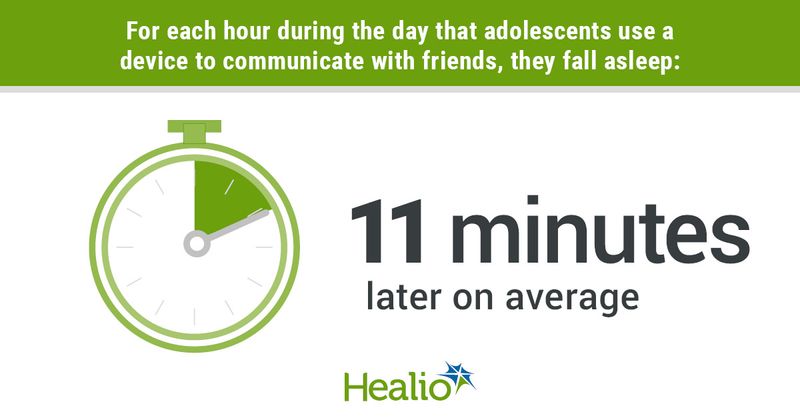Screen use delays sleep time for adolescents, study finds
Key takeaways:
- Adolescents’ sleep time was delayed by 11 minutes for every hour they used a device to communicate with friends.
- Study subjects spent an average of 2 hours per day communicating with friends via screen devices.
Adolescents fell asleep an average of 11 minutes later each night for every hour they used a screen device to communicate with friends during the day, according to a study published in the Journal of Adolescent Health.
Researchers enrolled 475 adolescents who provided an average of 4.8 days of daily survey and sleep data, with the latter being measured through actigraphy devices worn on their nondominant hand for 1 week.

“When the participant is least active, we can infer that they are likely asleep,” David A. Reichenberger, PhD, a postdoctoral scholar at Pennsylvania State University, said in a press release. “It’s more accurate than asking them how many hours they slept.”
Reichenberger and colleagues found that participants spent an average of 2 hours per day communicating with friends via email, instant messaging, texting on the phone or through social media, and slightly less time — about 1.3 hours per day — playing video games. They spent less than 1 hour per day surfing the internet and about 1.7 hours per day watching television or videos.
An hour before bed, children communicated or played video games via a phone, computer or tablet 77% of the time and watched television or movies 69% of the time.
Overall, the adolescents slept for an average of 7.8 hours per night, and for each hour throughout the day that they used screens to communicate with friends, they fell asleep about 11 minutes later on average, the researchers found.
Also, for every hour that they used screens to play video games, they fell asleep about 9 minutes later. Those who talked, texted or played games on a device in the hour before bed lost the most sleep, about 30 minutes.
“If teens typically play video games for an hour each day, but one day a new game comes out and they play for 4 hours, that's 3 additional hours more than they typically play,” Reichenberger said. “So, that means they could have 15 minutes of delayed sleep timing that night.
“For a child, losing 15 minutes of sleep at night is significant. It’s especially difficult when they have to get up in the morning for school; if they're delaying their sleep, they can't make up for it in the morning. Without adequate sleep, kids are at increased risk of obesity, as well as impaired cognition, emotion regulation and mental health.”
Reichenberger said the team found no significant associations between passive screen-based activities and subsequent sleep, like browsing the internet and watching television, videos and movies.
“It could be that these more passive activities are less mentally stimulating than interactive activities, like texting and video game playing.” Anne-Marie Chang, PhD, associate professor of biobehavioral health at Penn State, said in the release.
The prevalence of such devices makes it hard to put a limit on them, Chang added.
“But if you're really looking out for an adolescent’s health and well-being, then you might consider limiting the more interactive activities, especially in the hour before bed,” Chang said.
Younger children also affected
Sleep issues can affect younger populations as well, according to another study published in JAMA Network Open.
Researchers examined the effects of sleep disturbances among 17,182 preschool-aged children in Shanghai and found they were associated with emotional and behavioral difficulties.
Ultimately, the study found that the odds for incident emotional and behavioral difficulties were more than two times higher among participants with sleep disturbances.
References:
Deng Y, et al. JAMA Netw Open. 2023;doi: 10.1001/jamanetworkopen.2023.47623.
Interactive screen use reduces sleep time in kids, researchers find. https://www.eurekalert.org/news-releases/1010983. Published Dec. 13, 2023. Accessed Dec. 14, 2023.
Reichenberger DA, et al. J Adolesc Health. 2023;doi:10.1016/j.jadohealth.2023.10.027.

